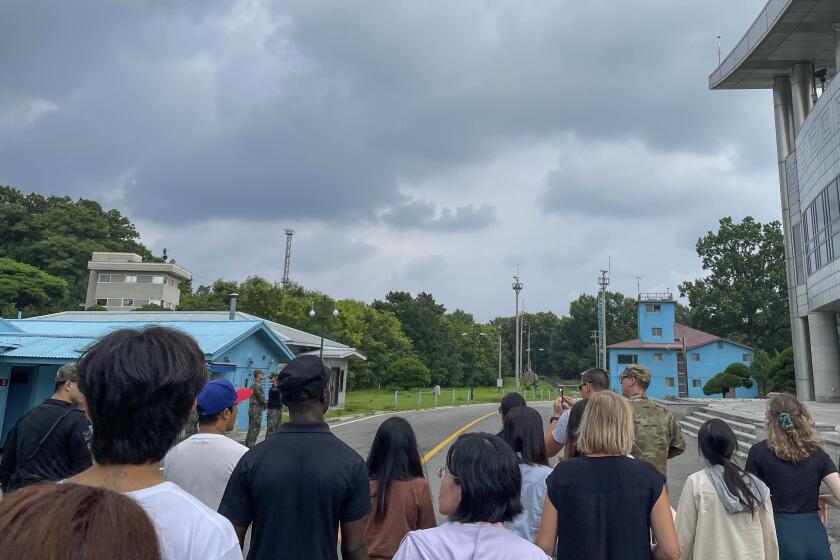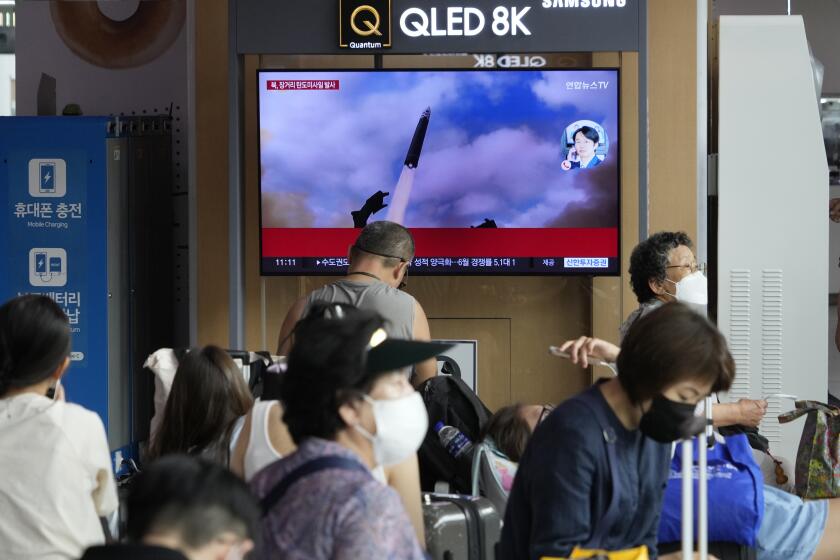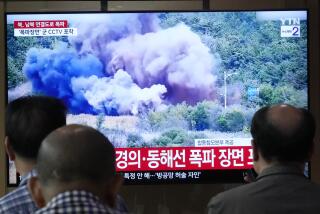North Korea fires 2 short-range ballistic missiles after U.S. submarine arrives in South Korea

- Share via
SEOUL — North Korea fired two short-range ballistic missiles into its eastern sea, South Korea’s military said Tuesday, adding to a recent streak in weapons testing that is apparently in protest of the U.S. sending major naval assets to South Korea in a show of force.
In its third round of launches since last week, North Korea fired the missiles just before midnight from an area near its capital, Pyongyang, according to South Korea’s Joint Chiefs of Staff. It said both missiles traveled about 250 miles before landing in waters off the Korean peninsula’s eastern coast.
Its statement called North Korea’s missile launches a “grave provocation” that threatens regional peace and stability.
The launches came hours after South Korea’s navy said a nuclear-propelled U.S. submarine — the USS Annapolis — arrived at a port on Jeju Island. That underscored the allies’ efforts to boost the visibility of U.S. strategic assets in the region to intimidate the North.
Last week, the USS Kentucky became the first U.S. nuclear-armed submarine to come to South Korea since the 1980s. North Korea reacted to its arrival by test-firing ballistic and cruise missiles in apparent demonstrations that it could make nuclear strikes against South Korea and deployed U.S. naval vessels.
Also on Monday, the American-led U.N. Command said it has started a conversation with North Korea about a U.S. soldier who ran into the North last week across one of the world’s most heavily fortified borders.
Andrew Harrison, a British lieutenant general who is the deputy commander at the U.N. Command, refused to say when the conversation started, how many exchanges have taken place and whether the North Koreans responded constructively, citing the sensitivity of the discussions. He also declined to detail what the command knows about Pvt. Travis King’s condition.
The U.S. soldier who bolted into North Korea could be used by Pyongyang for propaganda or as a bargaining chip to wrest concessions from Washington.
“I am in life an optimist, and I remain optimistic,” Harrison said during a news conference in Seoul.

In Washington, State Department spokesman Matthew Miller said North Korea had only “acknowledged” receiving the U.N. message last week and had not provided any information or commented further since then.
“There have been no new contacts since last week,” Miller said, adding that North Korea also had not responded to messages sent by U.S. civilian or military officials.
North Korea has remained publicly silent about King, who crossed the border during a tour of Panmunjom while he was supposed to be heading to Ft. Bliss, Texas, after his release from prison in South Korea on an assault conviction.
North Korea fired the missile after it threatened ‘shocking’ consequences to protest alleged spying by U.S. military flights.
The U.S. still has not been able to ascertain King’s condition, a senior administration official said Monday in Washington. Asked whether U.S. officials had a better understanding of whether King intended to defect, the official said they still had “no indication about what was going on in his mind that day.” The official was not authorized to comment publicly and spoke on the condition of anonymity.
Analysts say North Korea may wait weeks or even months to provide meaningful information about King to maximize leverage and add urgency to U.S. efforts to secure his release. Some say North Korea may try to wrest concessions from Washington, such as tying his release to the United States cutting back its military activities with South Korea.
King’s crossing came at a time of high tensions in the Korean peninsula, where the pace of both North Korea’s weapons demonstrations and the United States’ combined military exercises has intensified in a tit-for-tat cycle.
In between the ballistic and cruise missile launches last week, North Korea’s defense minister also issued a veiled threat, saying the Kentucky’s docking in South Korea could be grounds for the North to use a nuclear weapon against it. North Korea has used similar rhetoric before, but the statement underscored how strained relations are now.
The United States and South Korea have expanded their combined military exercises and increased regional deployments of U.S. aircraft and ships, including bombers, aircraft carriers and submarines, in a show of force against North Korea, which has test-fired about 100 missiles since the start of 2022.
The Annapolis, whose main mission is destroying enemy ships and submarines, is powered by a nuclear reactor but is armed with conventional weapons. The Annapolis mainly docked at Jeju to load supplies, but Jang Do Young, a spokesperson for South Korea’s navy, said the U.S. and South Korean militaries were discussing whether to arrange training involving the vessel.
Relatives of the U.S. soldier who sprinted across North Korea’s border say he may have felt overwhelmed by legal woes and a possible military discharge.
The armistice becomes 70 years old on Thursday, an anniversary South Korea plans to mark with solemn ceremonies honoring the dead that will involve invited foreign war veterans.
North Korea, which celebrates the day as victory day for the “great Fatherland Liberation War,” is preparing huge festivities that will probably include a military parade in the capital, Pyongyang, where leader Kim Jong Un may showcase his most advanced nuclear-capable missiles designed to target regional rivals and the United States.
North Korea’s state-run Korean Central News Agency said Monday that a Chinese delegation led by Li Hongzhong, vice chairman of the standing committee of the country’s National People’s Congress, will travel to North Korea to attend the celebrations.
Visits by foreign guests to North Korea have been extremely rare since the start of the pandemic, which prompted the North to seal off its borders to protect its poor healthcare system. North Korea since last year has been gradually reopening trade with China in an apparent effort to salvage a crippled economy damaged further by the previous two years of pandemic-related border controls.
More to Read
Sign up for Essential California
The most important California stories and recommendations in your inbox every morning.
You may occasionally receive promotional content from the Los Angeles Times.













